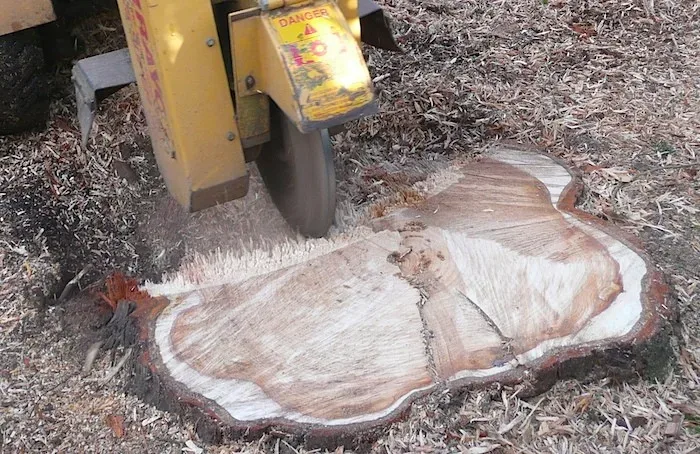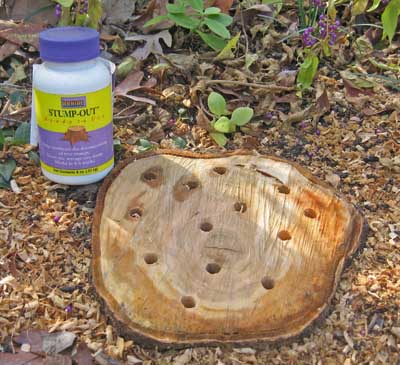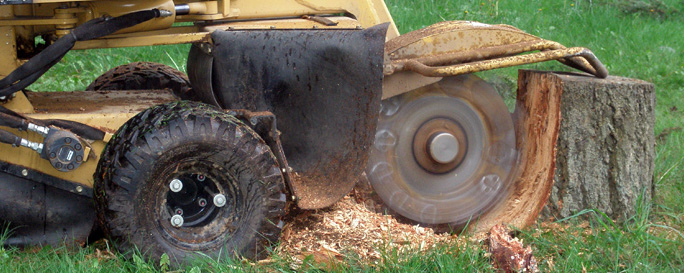
Written by Fergus Masons • September 17 Tree Stump Removal
Sometimes it’s time for your garden to say goodbye to a large old tree. Maybe you want a new look that it just won’t fit in to, or perhaps it’s become diseased and unsafe. You might have the tools and skills to fell it yourself; alternatively you can get a specialist in to do it. Either way, though, once the saws have finished their work and the tree’s gone your real problem will be revealed. You still have a stump.
Tree stumps are a nuisance. They’re unsightly, for a start, and they can be a trip hazard. Some species are also prone to throwing out suckers, so you’ll end up with the tree regrowing in a pretty messy way. Most of the time you’re going to have to get the stump out of the ground, but that’s much easier said than done. The stump itself is a solid block of wood, and there’s a lot more below the ground – the tree’s whole root system. Luckily the roots will usually die if the stump can be removed.
The problem is that unless it’s a small tree the stump isn’t going to come out easily. If it is small you might be able to dig down around it, chop through the main roots and pull it out. Slightly larger trees can also be extracted if you can get a vehicle or winch close enough to them. If you’re planning to do that you can cut the tree so there’s a good length of trunk remaining above the ground, ideally about six feet – that will give you more leverage to rip it out with. First dig out round the stump and cut as many roots as possible. Cut a notch high up on the back side of the stump and smooth it out, then fasten a sling round the trunk so it’s held in the notch. Shackle your winch or tow cable to the winch and hang a couple of cable dampers or heavy blankets on it – if the cable breaks it could be a serious hazard. Then slowly apply pull to the stump. The leverage should tear it loose.
If the stump’s too large to he hauled out, or it’s already been cut off close to the ground, there are other methods you can try. If the stump isn’t too damp or close to anything flammable you can probably burn it. Pile kindling round the stump then build a cone or pyramid of larger firewood over it; light it and keep feeding the fire for several hours. If you have the branches from the felled tree they make a convenient source of fuel and it’s also an easy way to get rid of those. Make sure the heart of the fire remains over the stump and eventually the bulk of it should be burned away. Be aware that a piece of wood that size can smolder for hours, and shouldn’t be left unattended until it’s completely burned out. At that point you should be able to break up what remains with an ax. Occasionally you might find that the core of the trunk is still unburned; if that’s the case chop away the surrounding charcoal and light another fire on the remains. Once it’s burned away to below ground level chop and dig out as much as possible, then backfill the hole. If you can dig out round the stump before building the fire you’ll destroy more of it, especially if you can pack firewood under the larger roots.
If you want the stump cleared but there’s no rush – it’s not in the way of the new deck you want to build, for example – there are methods you can use that won’t take as much hard labor to accomplish. Try getting a drill with a long spade bit and drilling close-spaced holes all over the top surface, or split it as much as possible with an ax or hammer and wedges. Then soak it with kerosene or fuel oil (not gasoline) and let it seep into the wood. Repeat daily for a week or two, and you’ll end up with a stump that’s completely dead and saturated in oil. At that point it should burn quite easily. It will still take a few hours to burn out, but once it’s done it should be easy to break up and remove.

The final option is possibly the quickest, but it means hiring a stump grinder. These are large power tools, usually on a wheeled cart, that act like a giant router – they have a spinning cutter underneath that will reduce the stump to chips. Once the above-ground part of it has been ground away the cutter can be lowered to attack the subsurface part and the major roots; usually you’ll be able to clear away everything to about a foot below ground level. Then you can backfill the hole with soil. Be aware that a stump grinder can be tricky to use, and will usually cost between $100 and $200 per day to hire. It’s worth hiring one if you have several stumps to dispose of, but if there are only one or two it could be cheaper to pay a stump removal specialist to do it for you.
Stumps are famously stubborn, but unless you insist on the brute force approach they can usually be removed without too much trouble. Just plan the process and find the most suitable method, instead of wading in there with a shovel and ax. Modern tools and chemicals mean it doesn’t have to be a difficult job.






